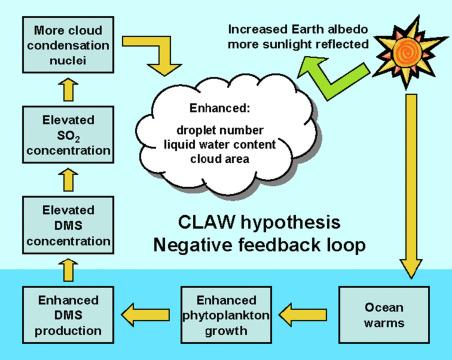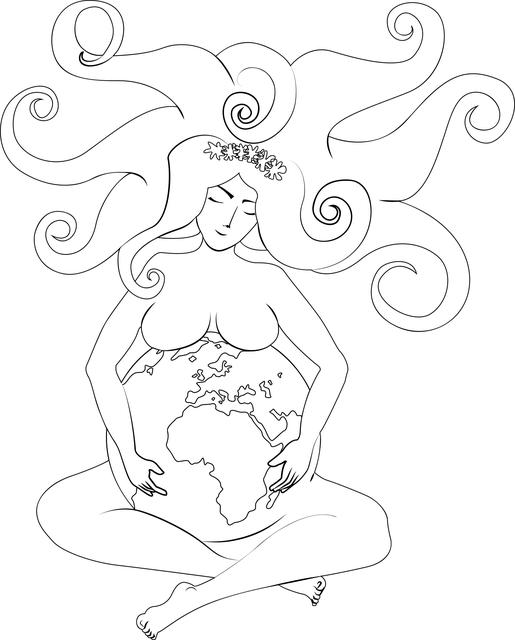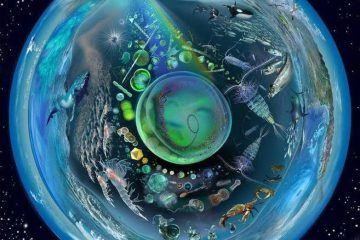Table of Contents
- Understanding the Fundamentals of Gaia Theory and Its Implications
- Real-World Examples of Gaia Theory in Action
- The Interconnectedness of Ecosystems and Their Role in Gaia Theory
- Practical Recommendations for Embracing Gaia Principles in Daily Life
- Exploring the Future: How Gaia Theory Can Influence Environmental Policies
- Q&A
- Closing Remarks
Understanding the Fundamentals of Gaia Theory and Its Implications
The Gaia Theory, conceived by scientist James Lovelock, posits that the Earth functions as a self-regulating system, where living organisms and their inorganic surroundings interact to maintain conditions conducive to life. At its core, this theory treats the planet as a single, complex organism whose various parts — from bacteria to trees, oceans to atmosphere — work harmoniously to sustain the delicate balance of life. This interconnectivity implies that small changes in one part of the system can have far-reaching effects, influencing climate, biodiversity, and even human health.
Exploring its implications reveals several critical insights:
- Interdependence: Every species plays a crucial role, emphasizing the importance of biodiversity for ecosystem resilience.
- Climate Regulation: Natural feedback mechanisms, such as those between plants and the atmosphere, help stabilize temperatures and maintain oxygen levels.
- Human Responsibility: As stewards of the planet, humans must consider the ecological consequences of their actions, leading to more sustainable practices.
To better understand the concepts inherent in this theory, consider the table below, which outlines key components and their roles in maintaining Earth’s equilibrium:
| Component | Role |
|---|---|
| Plants | Photosynthesis, oxygen production, and carbon dioxide absorption |
| Oceans | Temperature regulation and carbon sink |
| Bacteria | Nutrient cycling and organic material decomposition |
| Atmosphere | Climatic balance and shielding from harmful solar radiation |

Real-World Examples of Gaia Theory in Action
The Gaia Theory, proposed by James Lovelock, suggests that Earth’s biological and physical components interact synergistically to maintain conditions conducive to life. This concept is not merely theoretical; it manifests in various real-world examples that highlight the dynamic balance existing within ecosystems. For instance, the Amazon rainforest serves as a prime illustration. The dense vegetation produces significant moisture through transpiration, which contributes to cloud formation and rainfall, sustaining the forest itself and surrounding areas. This cycle exemplifies how living organisms influence their environment in a way that supports life.
Another compelling example can be observed in coral reef ecosystems. Coral reefs not only support an immense diversity of marine life but also play a crucial role in maintaining water quality. The relationship between coral organisms and symbiotic algae (zooxanthellae) demonstrates Gaia’s principles: the corals provide a habitat and nutrients for the algae, while the algae perform photosynthesis, offering oxygen and organic compounds to the corals. This delicate balance underscores how different life forms interact to create a stable environment, benefiting both parties while also influencing the greater ecosystem.
On land, the tundra biome showcases the principles of Gaia Theory through its resilience and adaptation to harsh conditions. Here, organisms like mosses and lichens not only survive but thrive, facilitating soil formation and providing nutrients. These plants regulate temperature and moisture levels, ensuring that even in extreme climates, life can persist. This interdependence highlights the role of flora in shaping their abiotic environment, reinforcing Lovelock’s notion that Earth functions as a single, self-regulating entity.

The Interconnectedness of Ecosystems and Their Role in Gaia Theory
The concept of interconnectedness among ecosystems plays a pivotal role in understanding Gaia Theory, which posits that the Earth and its biological systems behave as a single, self-regulating entity. This idea emphasizes how various components of the biosphere interact, creating a delicate balance that sustains life. For instance, forests, wetlands, oceans, and grasslands not only support diverse species but also contribute to essential life processes such as carbon cycling, water filtration, and nutrient recycling. The way these ecosystems interrelate underscores their importance in maintaining the health and stability of our planet.
Several key interactions within ecosystems exemplify the principles of Gaia Theory. For example:
- Pollination and Plant Growth: Bees, butterflies, and birds facilitate the reproduction of flowering plants, which in turn provide food and habitat for numerous species.
- Soil Formation and Erosion Control: Plants and decomposers work together to enrich soil health, reducing erosion and increasing its ability to retain water.
- Climate Regulation: Oceans and forests act as carbon sinks, mitigating the effects of climate change by absorbing carbon dioxide and regulating temperature.
Moreover, the interdependence of ecosystems can be illustrated in a simplified table that highlights their mutual benefits:
| ecosystem | Key Interactions | Benefits to Gaia |
|---|---|---|
| Forests | Photosynthesis and Habitat | Oxygen production, biodiversity support |
| Wetlands | Water Purification and Flood Control | Water quality enhancement, flood risk reduction |
| Oceans | Nutrient Cycling and Climate Regulation | Temperature stabilization, marine biodiversity |

Practical Recommendations for Embracing Gaia Principles in Daily Life
Embracing Gaia principles in your daily life can lead to harmonious living and sustainable practices that benefit both you and the planet. One of the easiest ways to start integrating these principles is by focusing on your consumption habits. Opt for local produce whenever possible to reduce carbon footprints associated with transportation. Furthermore, consider incorporating more plant-based meals into your diet, as this can significantly decrease your overall environmental impact. A few strategies include:
- Support farmers’ markets in your area.
- Plan meals for the week to minimize food waste.
- Grow your own herbs or vegetables, even in small spaces.
Another practical aspect is to enhance your home’s ecological footprint through conscious energy usage. By making simple changes, you can minimize energy consumption and promote sustainability. Implementing the following can make a significant difference:
- Switch to energy-efficient appliances and light bulbs.
- Utilize renewable energy sources, like solar panels if feasible.
- Practice mindful consumption by unplugging devices when not in use.
Lastly, fostering a community that values Gaia principles can amplify individual efforts. Engage with local initiatives focused on environmental conservation and preservation, and consider volunteering for projects that rejuvenate natural landscapes. Participation can be enhanced through:
- Joining local environmental groups to collaborate on efforts.
- Organizing or participating in clean-up drives in your community.
- Sharing knowledge about sustainable living with friends and family.
Quick Reference: Examples of Effective Gaia Practices
| Practice | Benefit |
|---|---|
| Local Sourcing | Reduces transportation emissions |
| Plant-Based Diet | Lowers carbon footprint |
| Community Engagement | Increases environmental awareness |

Exploring the Future: How Gaia Theory Can Influence Environmental Policies
The Gaia Theory, proposed by scientist James Lovelock, presents the Earth as a self-regulating organism where living organisms interact with their inorganic surroundings to maintain conditions conducive to life. This interconnectedness carries significant implications for how we approach environmental policies. Adopting the principles of Gaia could lead us to rethink traditional policy frameworks by emphasizing the vital relationships within ecosystems and recognizing the value of biodiversity. By focusing on systemic health rather than singular environmental metrics, lawmakers could create more holistic and sustainable approaches.
Incorporating Gaia Theory into environmental policy could result in actionable strategies such as:
- Integrated Resource Management: Encouraging the sustainable exploitation of natural resources while balancing ecosystem health.
- Adaptive Policy Frameworks: Developing flexible regulations that adapt to changing environmental conditions and scientific advancements.
- Community Engagement: Involving local populations in decision-making processes to foster a sense of stewardship over natural resources.
To visualize the potential impact of policies grounded in Gaia Theory, consider the following table that contrasts conventional policy approaches with those rooted in Gaia principles:
| Conventional Policy Approaches | Gaia-Inspired Approaches |
|---|---|
| Focuses solely on economic growth | Prioritizes ecological balance and health |
| Short-term solutions are favored | Emphasis on long-term sustainability |
| Neglects local ecological knowledge | Integrates indigenous and local insights into policymaking |
Ultimately, aligning environmental policies with the Gaia Theory could catalyze a shift towards more sustainable practices that honor the interdependence of life on Earth. By prioritizing ecosystem resilience and acknowledging the Earth’s regenerative capabilities, we can better address environmental challenges in a collaborative and forward-thinking manner.
Q&A
Q&A on Gaia Theory Examples
Q1: What is Gaia Theory? A1: Gaia Theory, first popularized by scientist James Lovelock in the 1970s, proposes that Earth functions as a self-regulating system where living organisms interact with their inorganic surroundings to maintain conditions suitable for life. Essentially, it suggests that the Earth and its biological systems behave as a single entity.Q2: Can you provide a real-world example of Gaia Theory in action? A2: A classic example of Gaia Theory is the regulation of atmospheric gases. For instance, plants play a crucial role in maintaining oxygen levels while consuming carbon dioxide. Through photosynthesis, they not only produce oxygen necessary for animal life but also absorb a significant amount of CO2, thereby influencing the climate and overall quality of the atmosphere. This balance is essential for sustaining life on Earth.
Q3: What role do oceans play in Gaia Theory? A3: Oceans are a vital component of Gaia Theory, acting as a buffer for climate changes and a habitat for countless species. Phytoplankton, microscopic plants in ocean waters, contribute significantly to carbon cycling. They absorb CO2 and produce oxygen. The health of oceans, influenced by its marine life, directly impacts atmospheric conditions, highlighting the interconnectedness proposed by Gaia Theory.
Q4: How does Gaia Theory relate to biodiversity? A4: Biodiversity is considered a fundamental aspect of Gaia Theory. The variety of life forms contributes to the resilience of ecosystems, enabling them to adapt to changing environments. Each species plays a role in maintaining ecological balance, supporting processes like nutrient cycling and energy flow. A decline in biodiversity weakens these systems, which can disrupt the Earth’s self-regulating capabilities.
Q5: Are there any criticisms of Gaia Theory? A5: Yes, while Gaia Theory has garnered significant support, it also faces criticism. Some scientists argue that it anthropomorphizes Earth, suggesting it is purposeful in its actions. Others believe that the theory lacks empirical support and can oversimplify complex ecological interactions. Nonetheless, many researchers appreciate the theory for raising awareness about environmental interconnectedness, even if they don’t fully align with its conclusions.
Q6: How can understanding Gaia Theory impact environmental policy? A6: Understanding Gaia Theory emphasizes the importance of viewing environmental issues holistically. As ecosystems are interconnected, policies need to consider the broader impacts of human activities. This perspective can guide sustainable practices, promoting conservation and restoration efforts, as well as encourage global cooperation in tackling climate change by recognizing our role in maintaining Earth’s balance.
Q7: Is Gaia Theory relevant in today’s context of climate change? A7: Absolutely. Gaia Theory provides a framework for understanding how human actions disrupt ecological balance, contributing to climate change. By recognizing the Earth’s self-regulating systems, individuals and policymakers can better appreciate the need for sustainable practices and environmental stewardship. It serves as a reminder that our well-being is intricately linked to the health of our planet.



0 Comments